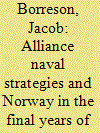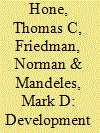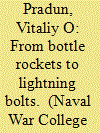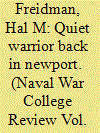|
|
|
Sort Order |
|
|
|
Items / Page
|
|
|
|
|
|
|
| Srl | Item |
| 1 |
ID:
111123


|
|
|
|
|
| Publication |
2011.
|
| Summary/Abstract |
F
or those of us who served in the Norwegian armed forces, especially in
northern Norway, the 1980s were exciting times. Norway seemed to be the
focus of American and NATO attention. There was a continuous flow of
high-ranking visitors to Defence Command North Norway (DEFCOMNON),
from the staffs of Allied Command Europe (ACE) and Atlantic (ACLANT).
1
Every year thousands of allied soldiers, hundreds of aircraft, and dozens of ships
arrived in the area to conduct advanced training and complex exercises. High
points were the deployments of U.S. Navy aircraft carriers, elements of Supreme
Allied Commander, Atlantic's (SACLANT's) Striking Fleet Atlantic, into northern Norwegian coastal waters in Vestfjorden, outside Bodø: in 1985, USS America (CV 66) and, in 1987, USS Forrestal (CV 59) in Exercise OCEAN SAFARI; in
1988, USS Theodore Roosevelt (CVN 71) and Forrestal in TEAMWORK; and in
1989, America in NORTH STAR.
2
We were witnessing, and took part in, what later
turned out to be the culmination of the Cold War-the period of tension that
eventually led to the collapse of the Soviet Union. Norway, neighbor to the Soviet Union and a coastal state on the North Atlantic and the Barents Sea, found
itself at the geographical center of this final effort.
|
|
|
|
|
|
|
|
|
|
|
|
|
|
|
|
| 2 |
ID:
111121


|
|
|
|
|
| Publication |
2011.
|
| Summary/Abstract |
In late 2006, Andrew Marshall, the Director of the Office of Net Assessment in
the Office of the Secretary of Defense, asked us to answer several questions: Why
had the Royal Navy (RN) developed the angled flight deck, steam catapult, and
optical landing aid before the U.S. Navy (USN) did? Why had the USN not developed these innovations, which "transformed carrier
design and made practical the wholesale use of
high-performance jet aircraft," in parallel with the
RN?
1
Once developed by the RN, how had these three
innovations "jumped the gap" to the USN?
|
|
|
|
|
|
|
|
|
|
|
|
|
|
|
|
| 3 |
ID:
111119


|
|
|
|
|
| Publication |
2011.
|
| Summary/Abstract |
In March 1996, China conducted military exercises and live missile firings in the
Taiwan Strait as a response to the increasingly pro-independence stance of Taiwan's president, Lee Teng-hui. The United States responded in turn by maneuvering two aircraft carrier groups into the island's vicinity. China and the United
States did not come to a standoff, and the issue ended peacefully, although not
without ominous messages being received by all parties. China had signaled its
willingness to use military force to check Taiwan's incipient independence ambitions, and the United States had conveyed its resolve to defend Taiwan against
aggression from the mainland.
|
|
|
|
|
|
|
|
|
|
|
|
|
|
|
|
| 4 |
ID:
111122


|
|
|
|
|
| Publication |
2011.
|
| Summary/Abstract |
The ability to operate freely, unthreatened by adversaries seeking to track and
target them or interfere with their communications, that the U.S. Navy's aircraft carriers have enjoyed for the last two decades is unlikely to continue. China
has been developing an antiaccess/area-denial capability, centered on antiship
ballistic missiles, that may soon be able to locate and attack U.S. carriers at considerable distances.
1
The Chinese People's Liberation Army has also developed
concepts for information warfare that integrate computer network operations,
electronic warfare, and kinetic strikes to degrade an opponent's ability to collect,
process, and disseminate information.
2
If combined effectively, antiship ballistic
missiles and attacks on information networks could endanger the U.S. Navy's
command of the sea.
3
|
|
|
|
|
|
|
|
|
|
|
|
|
|
|
|
| 5 |
ID:
111124


|
|
|
|
|
| Publication |
2011.
|
| Summary/Abstract |
War is about wreckage. Consequently, postwar periods tend to be about reconstruction, and that phenomenon is what this article is about. It sets
the scene for a larger exploration (the subject of projected sequels to the recent
book from which this article is adapted) of how a military-academic institution
-the Naval War College, in Newport, Rhode Island-attempted to readjust to a
peacetime period that entailed simultaneously the
start of a new type of conflict for the United States
(the Cold War) and with a revolutionary new weapon
(the atomic bomb). While the Cold War and the
Atomic Age were revolutionary in many respects, at
their outset the staff, instructors, guest lecturers, and
students at the Naval War College did not automatically or necessarily think so. To a great degree, American military officers in the immediate postwar period,
while acknowledging that atomic energy weapons and
"war during peace" were earth-shattering in one
sense, fell back on fairly traditional strategic, operational, and tactical concepts for meeting these new
challenges.
1
|
|
|
|
|
|
|
|
|
|
|
|
|
|
|
|
| 6 |
ID:
111120


|
|
|
|
|
| Publication |
2011.
|
| Summary/Abstract |
A key source of American leadership throughout our history has been
enlightened self-interest. We want a better future for our children and
grandchildren, and we believe that their lives will be better if other peoples' children and grandchildren can live in freedom and prosperity.
The belief that our own interests are bound to the interests of those beyond our borders will continue to guide our engagement with nations
and peoples.
NATIONAL SECURITY STRATEGY OF THE UNITED STATES, MAY 2010
|
|
|
|
|
|
|
|
|
|
|
|
|
|
|
|
|
|
|
|
|